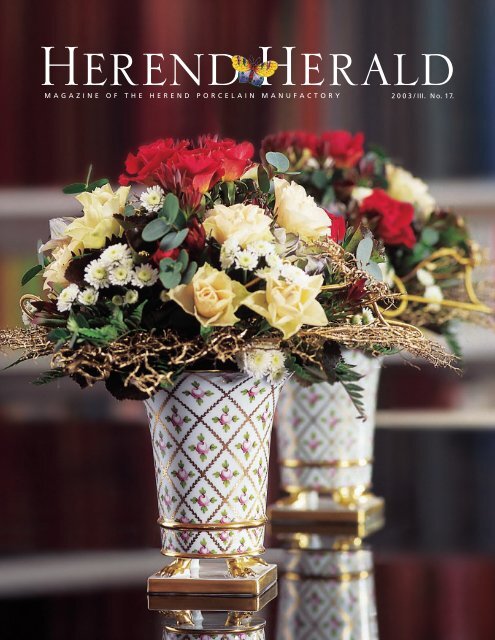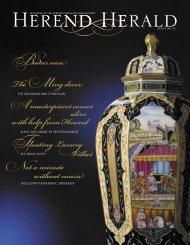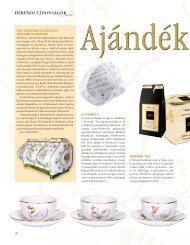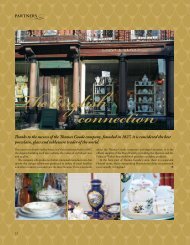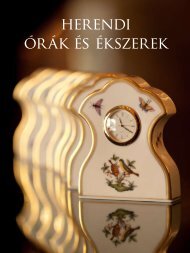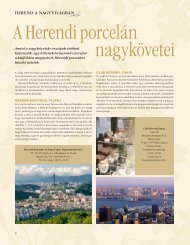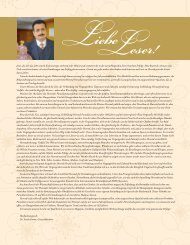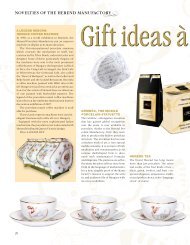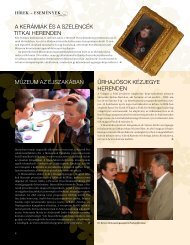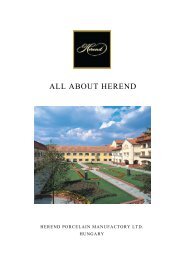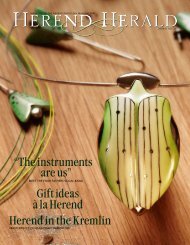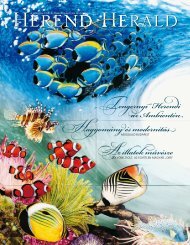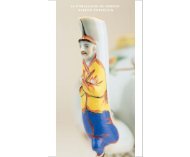Herend Herald
publication (15).pdf
publication (15).pdf
- No tags were found...
Create successful ePaper yourself
Turn your PDF publications into a flip-book with our unique Google optimized e-Paper software.
<strong>Herend</strong> <strong>Herald</strong><br />
MAGAZINE OF THE HEREND PORCELAIN MANUFACTORY<br />
2003/III. No. 17.
Dear Readers!<br />
You have before you the 17th issue<br />
of <strong>Herend</strong> <strong>Herald</strong>, for Autumn 2003.<br />
I’d like to draw your attention<br />
especially to the ‘Portrait’ feature,<br />
which introduces the founding<br />
father of the Red Nose Foundation<br />
in Hungary, Albert Royaards. He’s been busy in recent<br />
years with the Clown Doctors campaign that helps the<br />
recovery of children in hospital by touring the wards and<br />
dispensing a dose of laughter and fun. It’s been a few years<br />
now since Albert made his way from Hungary to his<br />
native Holland, on foot no less, to encourage people to<br />
give to this worthwhile cause.<br />
Hungary’s architectural treasures are represented by<br />
the Sándor Palace near the former Royal Palace of Buda<br />
Castle. After a chequered history and several decades of<br />
neglect, it’s been restored to its former glory as the official<br />
residence of the President of the Republic.<br />
The ‘Introductions’ section presents a series of charming<br />
little pictures that blend such different materials as<br />
porcelain, paper and wood. They blend the techniques of<br />
watercolours and porcelain painting in a way not found<br />
in <strong>Herend</strong> Porcelain before.<br />
The ‘Lifestyle’ feature is an intriguing one as well. Hats<br />
are perhaps the most conspicuous item of dress, at least<br />
in a crowd, because they are almost<br />
at eye level and supremely characteristic<br />
of the people who wear them.<br />
The history of headgear is a long and<br />
exciting one.<br />
Those who like to do things in<br />
good time will already be thinking of gifts for Christmas<br />
or Hanukkah. ‘Gifts’ is the feature to help them. ‘<strong>Herend</strong><br />
ABC’, on the other hand, presents some more of the<br />
repertoire of <strong>Herend</strong> décors, which are legendary for<br />
their variety.<br />
It was a busy summer for <strong>Herend</strong>, with several special<br />
events at home and abroad. ‘Events’ reports on them.<br />
May I wish you an enjoyable and informative read.<br />
<strong>Herend</strong>, October 2003<br />
ROBERT SOMOGYI<br />
Editor-in-chief,<br />
Director of Marketing and Sales
<strong>Herend</strong> <strong>Herald</strong><br />
MAGAZINE OF THE HEREND PORCELAIN MANUFACTORY<br />
Gyûtôk figyelmébe!<br />
Dear <strong>Herald</strong> Reader!<br />
THE EDITORS ALWAYS READ YOUR LETTERS WITH THE GREATEST INTEREST.<br />
Please continue to send your opinions, suggestions and observations about the magazine!<br />
DEAR COLLECTORS!<br />
We would like to draw your attention to the fact that limited copies Nos 13, 14, 15 and 16<br />
of the <strong>Herend</strong> <strong>Herald</strong> are still available from the editorial office.<br />
(H–1051 Budapest, József nádor tér 11. Phone: (+36 1) 267 4626 Fax: (+36 1) 317 69 74 E-mail: herald@herend.com)<br />
THE MAGAZINE CAN BE ORDERED BY MAIL OR ON THE INTERNET<br />
PUBLISHER <strong>Herend</strong> Porcelain Manufactory Ltd, H–8440 <strong>Herend</strong>, Kossuth Lajos u. 140. Phone: +36 88 523 185<br />
Fax:+36 88 261 518 E-mail: herald@herend.com Website: http://www.herendherald.hu EDITOR-IN-CHIEF Robert Somogyi<br />
DESIGN Dominika Kiss PHOTOS Zoltán Bakos, Zsolt Bak, Kornél Kovács, József Varga, Judit Volák<br />
COPY EDITOR Tamás Halász AUTHORS Rita Cserhalmi, dr. Melinda Hegedûs, Tamás Halász, dr. Károly Kasza,<br />
Tamás Köller, dr. Endre Kôrös, Brigitta Pucsek, Tibor Szuszky, Orsolya Tölgyes<br />
EDITORIAL H–1051 Budapest, József nádor tér 11. Phone:+36 1 267 4626 Fax:+36 1 317 69 74 ISSN 1585–1397<br />
2<br />
<strong>Herend</strong> <strong>Herald</strong>
COVER<br />
Vase with Sèvres<br />
petites roses en or<br />
(SPRO) décor<br />
Photo: Zoltán Bakos<br />
Tartalom Contents<br />
RETAIL<br />
4<br />
22<br />
PORCELAIN<br />
Pia Rubio in Madrid<br />
12<br />
MANUFACTURING 3.<br />
Assembly, drying, biscuit firing<br />
ARCHITECTURE<br />
6<br />
The Sándor Palace<br />
24<br />
GIFTS—PORCELAIN<br />
Late summer picnic<br />
INTRODUCTIONS<br />
10<br />
MID series:<br />
Wonders of nature<br />
26<br />
LIFESTYLE<br />
Hats<br />
16<br />
INTERVIEW<br />
12<br />
30<br />
EVENTS<br />
Albert Royaards, director<br />
of the Red Nose Clown Doctors<br />
Foundation in Hungary<br />
DINING CULTURE<br />
Porcelain on the table :<br />
Superlatively served<br />
HEREND ABC<br />
New decorations<br />
16<br />
18<br />
28<br />
<strong>Herend</strong>–Tabu Old Timer Cup<br />
I am sailing …<br />
Stud traditions rivive at Kisbér<br />
Festival of horsemanship at Aachen<br />
Gödöllô – Baroque Days<br />
Lobmeyr exhibition at <strong>Herend</strong><br />
<strong>Herend</strong> exhibition at the<br />
Benedictine Abbey of Tihany<br />
New <strong>Herend</strong> brand store opened<br />
in London<br />
Home&Garden in Munich<br />
Anna ball<br />
GASTRONOMY<br />
20<br />
40<br />
PREVIEW<br />
From the menu of the<br />
Apicius Restaurant<br />
Coming up in the next issue<br />
<strong>Herend</strong> <strong>Herald</strong> 3
RETAIL<br />
Pia Rubio<br />
HEREND IN MADRID, IN EXCELLENT COMPANY<br />
The Pia Rubio porcelain salon is in Calle Padilla, an exclusive shopping street in the centre<br />
of the fashionable Salamanca district of the Spanish capital. The masterpieces<br />
of <strong>Herend</strong> Porcelain are in good company there, amidst those of a select handful of European<br />
porcelain brands such.<br />
Pia Rubio first visited the <strong>Herend</strong> Porcelain Manufactory<br />
last year. And she was so entranced, she decided to add<br />
Hungary’s handmade, hand-painted porcelain to the<br />
range in her downtown store. Pia Rubio, selling fine<br />
tableware and ornamental porcelain, is becoming a favourite<br />
haunt with Madrid society and foreign visitors as<br />
well. Señora Rubio has chosen a discriminating range of<br />
<strong>Herend</strong> articles, and her affection for <strong>Herend</strong> Porcelain<br />
has been deepening ever since. The store caters to the<br />
art of the table in every way. Porcelain is joined there<br />
by Baccarat crystal glass and Ercuis and Sabre cutlery<br />
and silverware. There are coffee and tea services, candlesticks,<br />
ashtrays, table lamps, ornamental pieces for collectors,<br />
and delicately hand-painted eggs. Pia Rubio has<br />
an enviable reputation in Spain as the finest and most<br />
exclusive of porcelain retailers.<br />
Business with Señora Rubio is based firmly on close<br />
personal connections with porcelain makers and other<br />
suppliers. This, she knows, is essential to offering the<br />
highest quality range speedily and efficiently, and at<br />
4<br />
<strong>Herend</strong> <strong>Herald</strong>
RETAIL<br />
competitive prices. Her choice of <strong>Herend</strong> décors includes<br />
personal favourites such as Rothschild, Kitty and<br />
Bouquet de Fruits.<br />
Those unwilling to carry away their own purchases are<br />
invited to avail themselves of the store’s domestic and<br />
foreign delivery service. Regular clients are to be found<br />
throughout the country, but the most avid of all, we were<br />
told, are the collectors of Madrid, Bilbao and Seville.<br />
There were several hundred guests at the summer opening,<br />
keen to ‘christen’ the store by making purchases.<br />
The greatest interest was shown in the table services,<br />
notably the classic Victoria pattern, which first caught an<br />
English queen’s eye in 1851.<br />
Pia Rubio S.L., Calle Padilla 18, 28006 Madrid, Spain<br />
Phone: + 34 91 431 16 37. Fax: +34 91 431 16 37.<br />
porcelana@piarubio.es<br />
http://www.piarubio.es/index.html.<br />
<strong>Herend</strong> <strong>Herald</strong> 5
Palace Sándor<br />
THE<br />
ON BUDA HILL<br />
St George’s Square has become one of the most spectacular places on Buda Castle Hill<br />
again. Archaeologists are still at work, but the square is now dominated as it<br />
should be by the Sándor Palace, beautifully restored to its original elegance, after<br />
near-devastation in World War II and decades as a sad, empty reminder of<br />
a bitter siege. Today it serves as the official residence of the country’s head of state,<br />
the President of the Republic.<br />
6<br />
<strong>Herend</strong> <strong>Herald</strong>
ARCHITECTURE<br />
The address of the palace today is Szent György tér 1–2,<br />
but in the Middle Ages it was Sigismund Square, named<br />
after St Sigismund’s Market. There was a church on the<br />
north side dedicated to the saint and founded by King<br />
Sigismund (Zsigmond) of Hungary (1387–1437), who was<br />
also elected Holy Roman Emperor in 1433. The church<br />
was later the resting-place of Catherine Podjebrád, the first<br />
wife of King Matthias I (1458–1490). The foundations are<br />
among the things the archaeologists have found, although<br />
the church was converted into a djami by the Turks and<br />
badly damaged in the recapture of Buda by Christian<br />
forces in 1686.<br />
The square was then renamed after two barracks that<br />
were built there. In 1849, it became Hentzi-platz for a<br />
while, after a hated imperial commander-in-chief of<br />
Buda Castle during the reprisals after the 1848–9 War of<br />
Independence. Its modern name dates from 1879.<br />
The Sándor Palace, besides being of great historical<br />
note, is firmly on the tourist trail: near the former Royal<br />
Palace and right by the upper end of the Sikló, a 95-metre<br />
cable railway bringing visitors and locals up from the<br />
Danube embankment, completed in 1870, destroyed in<br />
World War II, completely reconstructed, and reopened<br />
in 1986. The other neighbour (in adjacent Színház utca)<br />
is a former Carmelite priory and church, whose history<br />
has been equally chequered. The 13th-century Franciscan<br />
church on the site was also turned into a djami, but<br />
rebuilt in 1736 by the Carmelites. When the order was<br />
dissolved in Hungary by Joseph II in 1782, designs were<br />
drawn, with royal permission, by the great polymath Farkas<br />
Kempelen to convert the premises into a theatre,<br />
which it remained from 1787 to 1925. War damage was<br />
severe, but it reopened in 1977 and has housed National<br />
Dance Theatre since 2001.<br />
The Habsburg dynasty tended to ignore Buda, but the<br />
city’s importance grew nonetheless, so that the site where<br />
the south wing of the Franciscan friary had stood about<br />
1270 became a rich prize. The barracks erected after the<br />
recapture of Buda were used until 1803, when the site<br />
with its dilapidated buildings was acquired by Count Vince<br />
Sándor for a Buda residence.<br />
Art historians still differ about whether Mihály Pollack<br />
or Johann Aman was the architect and builder of the<br />
Sándor Palace. Hardly thirty years old, Pollack had already<br />
shown his abilities in earlier works, although his main<br />
<strong>Herend</strong> <strong>Herald</strong> 7
ARCHITECTURE<br />
buildings were to follow in the 1810s and 1820s. The front<br />
of the palace, with its strong horizontal lines (emphasized<br />
by the cornices, the long balcony and the thin band of<br />
relief), resembles Viennese palaces of the period. It was<br />
completed in 1806, with a main front facing southward<br />
towards the Danube and a side front westward onto St<br />
George’s Square.<br />
The first residents were Count Vince Sándor, his wife<br />
Countess Anna Szapáry, and their son Móric Sándor, a<br />
raffish character known as the Devil’s Horseman for his<br />
riding skills and habit of entering drawing rooms on<br />
horseback. Count Móric Sándor later sold the palace to<br />
the family of Marquis Pallavicini.<br />
The Hungarian independence forces managed in 1849<br />
to retake Buda Castle from the Austrians after a long siege<br />
that caused grave damage to the Royal Palace and in St<br />
George’ Square, which was the focus of the fighting. Hungary<br />
was defeated later in the year. Restoration of the<br />
Royal Palace was a long business, which left Archduke<br />
Albrecht, appointed military and civilian governor of<br />
Hungary in 1851, with nowhere to live. The Sándor Palace<br />
was relatively unscathed and he moved there until 1856.<br />
This also gave what had been a family home a government<br />
function. From 1867 onwards, it was rented (and later<br />
bought) by the Hungarian state from the Pallavicini family<br />
and put at the disposal of the prime minister and<br />
government.<br />
Gyula Andrássy and 19 subsequent Hungarian prime<br />
ministers lived and worked there.The palace shows characteristics<br />
of three different periods marked by three<br />
different tastes: the early 19th century, the 1860s and the<br />
1920s–1930s. The first owners had decorated and furnished<br />
the rooms in the Empire style, but this was changed to<br />
Neo-Baroque after 1867. After the First World War, the<br />
functions of the prime minister’s office were one factor<br />
behind a return to an Empire style similar to the original.<br />
The work of converting the Sándor Palace into a centre of<br />
government and prime ministerial residence, incidentally,<br />
had gone to Miklós Ybl, a pupil of Pollack’s responsible<br />
more than any other architect for shaping the appearance<br />
of Pest-Buda.<br />
The palace suffered heavy destruction in the Second<br />
World War, especially in the siege of Budapest. Photographs<br />
show the south wing collapsed down to the ground<br />
floor. Under the rubble, the lovely reliefs were all destroyed<br />
except one, entitled the Triumph of Venus. What<br />
the bombing did not destroy was soon pilfered. (A small<br />
number of remains stored in the basement of the Technical<br />
University were shipped to the Soviet Union as war<br />
reparations.) Many irreplaceable statues and paintings<br />
were lost. So was the original furniture of the Baroque<br />
Salon, with tapestried upholstery donated to the Hungarian<br />
Chancery in Vienna Empress Maria Theresa.<br />
After the war, efforts were confined to preserving the<br />
ruins by roofing them over again.<br />
Hardly anything was done to change the state or condition<br />
of the building until 1989, when a start was made to<br />
patching up the exterior. For a few years, exhibitions were<br />
held in the romantically, painfully dilapidated rooms.<br />
After the change of system in 1989–90, there was talk<br />
of moving some government functions back from Pest to<br />
Buda Castle, and a government decision on renovations<br />
was passed in 1993. Four years later, it was decided to<br />
give the Sándor Palace a full, historically authentic restoration,<br />
and under the Orbán government of 1998–2002,<br />
the building was designated as the future residence of<br />
the prime minister.<br />
Preliminary work on the palace (archaeological excavations<br />
and exploration of the walls) was done in 1994–8.<br />
The documentation required for work on a scheduled<br />
historical building was prepared. The recommendations<br />
for internal and external restoration aimed at a degree<br />
of authenticity unprecedented in Hungary. The result is<br />
not a restoration in the classic sense, more a paraphrase<br />
8<br />
<strong>Herend</strong> <strong>Herald</strong>
ARCHITECTURE<br />
<strong>Herend</strong> porcelain in the Sándor Palace<br />
or reinterpretation. Instead of choosing a putative state<br />
at a specific time as the target of restoration, each area<br />
and room has been assessed separately and had the most<br />
characteristic detail chosen for it.<br />
The basis for the designs was a series of photographs<br />
taken at the time of Ybl’s restoration and others found<br />
in the family archives of Count István Tisza, prime minister<br />
in 1903–5 and again in 1913–17. For each part of<br />
the palace, the team chose the most authentic of the<br />
many previous restorations, and also considered which<br />
would be practical for the building’s future function as a<br />
residence and offices.<br />
Marks of each period appear, and yet the building preserves<br />
a sense of historical continuity and unity in its<br />
architecture and the interiors created to integrate with<br />
it. The reliefs on the front, to replace the ones destroyed<br />
in the war, were carved as replicas of the originals by<br />
notable sculptors. The furniture and fittings were destroyed<br />
as well, and some of these were also replicated<br />
from photographs, while others have been replaced by<br />
similar pieces of the same period. The plenary meeting<br />
room on the north side marks a transition between the<br />
residence and the offices, which have modern furniture<br />
and equipment in line with their functions.<br />
The full restoration was completed in the spring of<br />
2000. On January 23, 2003, President Ferenc Mádl and<br />
his staff moved into the Sándor Palace.<br />
<strong>Herend</strong> <strong>Herald</strong> 9
INTRODUCTIONS<br />
Surprises are part of the experience for customers of the <strong>Herend</strong> Porcelain Manufactory,<br />
in the shape of artistically devised pieces designed to appeal. The latest surprise is a series called<br />
Les merveilles de la nature (MID), which blends harmoniously several materials: porcelain,<br />
paper and wood.<br />
Wonders of<br />
LES MERVEILLES DE LA NATURE<br />
NATURE<br />
These ‘wonders of nature’ are meticulously<br />
painted little panels of porcelain<br />
with a pale passe-partout and<br />
a coloured frame.<br />
The motifs are little details of plant,<br />
animal and fruit compositions.These<br />
overflow intriguingly from the porcelain<br />
panel onto the surrounding<br />
mat of a passe-partout, where they<br />
are projected into watercolours. This<br />
combination of the two techniques<br />
of porcelain painting and watercolours<br />
lends a special atmosphere to<br />
the pictures.<br />
10<br />
<strong>Herend</strong> <strong>Herald</strong>
INTRODUCTIONS<br />
A sense of animation is added because<br />
the watercolour details on the<br />
passe-partout do not necessarily continue<br />
the painting on the panel so<br />
much as develop and comment on<br />
it. An example is MID–4: the watercolours<br />
show a butterfly about to land<br />
on the flower on the panel. In MID–7,<br />
a watercolour insect is fleeing from<br />
the warbler depicted on the porcelain.<br />
The fruits, animals and flowers of<br />
the series are all lent a special character<br />
by the twin painting techniques<br />
and the animated composition of the<br />
pictures.They have been a great success,<br />
and as the treasures of nature<br />
are inexhaustible, there will be new<br />
items joining them from time to time.<br />
<strong>Herend</strong> <strong>Herald</strong> 11
Miles of smiles<br />
ALBERT ROYAARDS<br />
DIRECTOR OF THE RED NOSE CLOWN DOCTORS<br />
FOUNDATION IN HUNGARY<br />
Red Nose Clown Doctors give thousands of sick children around the world moments of fun that<br />
help them forget their pain and discomfort. Their work is becoming built into the treatment,<br />
along with the realization that the psychological wellbeing of young patients can be as important<br />
as medical advances. Clowns and doctors work together in Hungary too, thanks largely<br />
to the dedication and initiative of the head of the Foundation here, Dutchman Albert Royaards.<br />
The management of the <strong>Herend</strong> Porcelain Manufactory<br />
has agreed to support the Foundation’s efforts to benefit<br />
children in hospital.A practical outcome of the arrangement<br />
is that this issue of the magazine contains a<br />
brochure outlining the Foundation’s activities, so that<br />
readers in Hungary may support its work directly using<br />
the payment cheque. Furthermore, the <strong>Herend</strong> stores<br />
in Hungary now contain Red Nose collecting urns for<br />
donations.<br />
<strong>Herend</strong> <strong>Herald</strong>: We asked Albert Royaards when the<br />
Clown Doctors movement began and how Hungary<br />
became involved in this international activity.<br />
Albert Royaards: The first ‘clown therapy’ department<br />
was started by a New York clown, Michael Christensen,<br />
who had the idea when he went to see his sick sibling<br />
in hospital. The initiative in the United States was followed<br />
by similar foundations in Austria, France and the<br />
Netherlands. These days there are clown doctors at work<br />
12<br />
<strong>Herend</strong> <strong>Herald</strong>
INTERVIEW<br />
in hospitals in Romania, Slovakia, the Far East, Australia<br />
and Latin America. The Hungarian Foundation was started<br />
in 1996 by the Red Nose foundation in Austria and<br />
has operated as a non-profit organization here since<br />
1997, relying entirely on donations. Starting in just one<br />
hospital, our clown doctors began to work at the Madarász<br />
utca hospital in Budapest in May 2000, then at the Buda<br />
Children’s Hospital in October 2001 and the Bethesda<br />
Children’s Hospital. The latest to join the programme in<br />
Budapest is the Svábhegy Children’s Infirmary. Meanwhile<br />
the first provincial hospital covered was the children’s<br />
ward at the Aladár Petz County Hospital in Gyôr, which<br />
joined in December last year. Two more hospitals in Budapest<br />
and three in the provinces will be taking up clown<br />
therapy in the near future.<br />
Turning to the question of effectiveness, not easy to<br />
measure, we asked what the Clown Doctors were undertaking<br />
in medical terms.<br />
Our work’s entirely concerned with improving the<br />
condition of child patients in hospital. This means our<br />
clowns visit the young patients in participating hospitals<br />
once or twice a week. Parents and doctors have consistently<br />
emphasized the beneficial effects of the regular<br />
presence of Clown Doctors. Children become more cheerful<br />
and forget their pain and sorrow, which is a key to<br />
effective recovery.<br />
So who works in the programme?<br />
Our Clown Doctors are specially trained performers<br />
who put everything they have into gauging and understanding<br />
the psychological needs of the children receiving<br />
hospital treatment and apply their knowledge,experience<br />
and talents to the healing task.We have long-term<br />
contracts with our Clowns and give them regular training<br />
to make them maximally suited to a special, difficult<br />
role. The training involves child psychologists and specialists,<br />
as well as the performance coach. There are 17<br />
Clown Doctors at work in Hungary at present.<br />
Albert Royaards went on to explain what happens when<br />
the Clown Doctors do their rounds:<br />
The most important aspect is personal contact, quickly<br />
establishing a cheerful atmosphere. Clown Doctors do that<br />
by making music, singing, playing with dolls, juggling,<br />
or using their improvisational skills.They do conjuring<br />
and magic to help dispel children’s fear of the hospital.<br />
Before they start, they’re briefed thoroughly, of course,<br />
<strong>Herend</strong> porcelain clown<br />
The Red Nose Fundation receives 10 per cent from<br />
the sales of the clown figure<br />
by doctors and nurses about the conditions of the patients.<br />
Special attention is paid to the long-term patients,<br />
those who have to keep coming back for treatment, or<br />
those who aren’t visited.The Clowns also make contact<br />
with the parents and staff as well.<br />
So about how many child patients are involved?<br />
There were 3084 patients involved in 1999 and 6250 in<br />
2001. Our mounting activity was recognized in 2002 with<br />
a Pál Heim Commemorative Medal from the Society of<br />
Hungarian Paediatricians, as a mark of our consistent and<br />
outstanding work on behalf of the recovery of children.<br />
In the spring, Albert Royaards made a conspicuous<br />
personal contribution to making the Foundation better<br />
known:<br />
On May 1, 2002, I set off from Sárospatak to Utrecht<br />
in Holland, on foot. I did 25 kilometres a day for four<br />
months, with a day’s rest every week. My purpose on the<br />
way was to make as many firms, institutions and private<br />
individuals as possible aware of the Foundation’s work<br />
and gather donations to support the Clown Doctors. The<br />
start and the finish had to do with my family history and<br />
the historic links between the Netherlands and Hungary.<br />
A great many students of the Reformed College in Sárospatak<br />
made the same journey centuries ago. These<br />
‘peregrines’ were fired with a determination to complete<br />
their law, medicine or theology studies in Western Europe,<br />
often in Holland. Utrecht was the destination for<br />
many of them in the 17th–19th centuries, and that’s where<br />
I graduated in law as well. My ancestors were once wellknown<br />
theology professors at Utrecht University, and<br />
<strong>Herend</strong> <strong>Herald</strong> 13
INTERVIEW<br />
many of their works can be found in the library of Sárospatak<br />
College.<br />
As a lawyer and economist, Albert Royaards spent 17<br />
years in Singapore, running his own financial consultancy.<br />
It was a brave decision suddenly to accept the president’s<br />
chair in a foundation for sick children in East-Central<br />
Europe, and to cross Europe on foot to further the cause.<br />
What motivations lie behind his work?<br />
I’ve never really analysed my decisions in those terms.<br />
I’m the father of six and of course I love my children and<br />
all children. One of my own was diagnosed with diabetes<br />
CLOWN DOCTORS FOUNDATION<br />
BUDAPEST, ZRÍNYI U. 14. I. EM. H-1051, HUNGARY<br />
PHONE (+ 36 1) 302 44 52<br />
ACCOUNT NO. (HVB BANK)<br />
10918001-00000009-71700024<br />
HUNGARIAN TAX NO. 18090628-2-41<br />
WEBSITE WWW.PIROSORR.HU<br />
EMAIL PIROSORR@AXELERO.HU<br />
before the age of one and lay between life and death for<br />
several months. It was a ghastly experience that I’ve never<br />
forgotten. I felt as if that trial had given me a vocation,<br />
to do something really good and important in life. My<br />
work now allows me to utilize the experience, connections,<br />
endurance and willingness I’ve built up over the<br />
years. I’ve headed the organization for two-and-a-half<br />
years. During their first four years of operation, the Clown<br />
Doctors of the Red Nose Foundation in Hungary were<br />
able to visit only one hospital and there were only 3–4<br />
people involved. It’s extremely difficult to find donors and<br />
sponsors in Hungary. When I applied for the president’s<br />
job, I saw that as a real challenge. Our work is still extremely<br />
difficult, but I can now see clearly that provided<br />
the country’s development continues at the same pace,<br />
there will be no perceptible difference between Hungary<br />
and the Netherlands in terms of running a foundation<br />
such as this. After my arrival, I steadily involved<br />
myself in the Foundation’s work, and my commitment<br />
to it has grown to such an extent that it occupies every<br />
moment of my time. My function at the Foundation provides<br />
a real opportunity to do so.’<br />
Apart from the job, what prompted Albert Royaards’<br />
decision in 1996 to move to Budapest?<br />
I fell in love with Budapest and made it my ‘base’.<br />
Although I spent a lot of time in Holland as well, with<br />
my children, I basically live here. Singapore, where I<br />
spent almost two decades, is so far away. Holland is too<br />
small. For a long time, I’d never been to East-Central<br />
Europe, although I’d worked in countries like Kazakhstan,<br />
Bulgaria and Ukraine. Then one day I arrived in Budapest<br />
and said to myself, ‘This is it!’ I was enchanted by<br />
the architecture, the history, the rich past, the cultural<br />
traditions, and the strange language, which I now speak<br />
a little.<br />
Does he have any personal experiences to do with<br />
<strong>Herend</strong> Porcelain?<br />
The art of <strong>Herend</strong> has long had a big reputation in Holland.<br />
Many friends of mine have received lovely <strong>Herend</strong><br />
Porcelain services as wedding presents. During my long<br />
walk, I was glad to sense for myself the warmth of this<br />
porcelain at a dinner I was invited to. Hardly surprisingly,<br />
it inspired me to initiate relations between <strong>Herend</strong> and<br />
the Red Nose Foundation.<br />
14<br />
<strong>Herend</strong> <strong>Herald</strong>
R O S E M A K I N G , P I E R C I N G , A S S E M B L Y , T H R O W I N G<br />
Porcelanium – <strong>Herend</strong><br />
A visit to the Porcelanium Visitors’ Centre at <strong>Herend</strong> provides insights into the most fascinating aspects of<br />
porcelain manufacturing. Visitors have a chance to try for themselves as well.<br />
For those who really like <strong>Herend</strong> Porcelain, it’s a dream come true. Master craftsmen and craftswomen<br />
are at hand to instruct and assist you to make pieces out of original <strong>Herend</strong> porcelain paste.<br />
Individual visitors are welcome to the Porcelanium any time during opening hours. Groups are asked to agree<br />
on a time beforehand.<br />
<strong>Herend</strong>, Kossuth Lajos utca 137, H–8440, Hungary • Phone: (00 36 88) 523 190<br />
www.herend.com • porcelanium@herend.com
Composition de fruits, Guirlande de Liechtenstein, Rothschild and Mosaîques triangulaires et fleurs des champs décors<br />
Superlatively<br />
PORCELAIN ON THE TABLE 1.<br />
SERVED<br />
16<br />
<strong>Herend</strong> <strong>Herald</strong>
DINING CULTURE<br />
Before the secret of making porcelain was known in Europe, the tableware<br />
of the rich would be made of silver, faience, maiolica or creamware. The<br />
poor made do with pewter, earthenware or wood. Porcelain services imported<br />
from the Far East appeared only in the grandest courts, as possessions<br />
prized for their rarity and cost.<br />
Once the secret of making true porcelain had been cracked in Europe in<br />
1709, it soon gained a reputation as the most perfect, attractive and durable<br />
material for table services. Early European porcelain drew heavily on Far<br />
Eastern ceramics and on the forms of silver and pewter ware.But designs<br />
and decoration peculiar to porcelain soon developed, tailored to suit royal<br />
courts or more modest buyers.<br />
The early 18th century saw the development of table services in the modern<br />
sense, consisting of matching plates, dishes and vessels for tea, coffee,<br />
sweetmeats and chocolate, with various accessories. The number of pieces<br />
in a service varied widely, from a hundred to a thousand. The most famous<br />
early service of all was the Swan Service made by Johann Joachim Kändler<br />
in 1737–41 for Count Heinrich von Brühl, the Saxon premier, consisting of<br />
2200 pieces, decorated and augmented with aquatic creatures in sculpture<br />
and relief.<br />
Separate dessert services developed in the mid-18th century and might<br />
consist of 500 pieces. They might consists of simple dessert plates, stands<br />
and dishes for cakes and fruit, sauce boats, compôtiers, ice-cream cups, and<br />
coolers for wine, ice cream and fruit. Towards the end of the 19th century,<br />
they became amalgamated again with general table services.<br />
As aristocratic table manners and customs become ever more refined and<br />
the number of dishes, sauces and desserts increased, so porcelain articles<br />
were devised to accommodate them. Alongside the salt cellars, mustard pots,<br />
napkin rings, butter dishes, salad bowls, bonbonnières, serving spoons and<br />
jugs appeared en suite vases, candlesticks, subtleties and centrepieces,<br />
modelled into a building, church, bouquet or human figure. One type of<br />
centrepiece for the table was the épergne, which incorporated various<br />
dishes, cruets and salt cellars extending from a central column.<br />
The <strong>Herend</strong> factory has been offering ever more beautiful table services<br />
since the 1840s. These days, a simpler service consists of 12 soup plates, 36<br />
dinner plates and 12 side plates, a soup tureen, three meat dishes, four round<br />
dishes, a salad bowl and a fruit salad bowl, a compôtier, a sauce boat on<br />
a plate, four salt cellars,12 eggcups,12 bone plates and 12 salad plates—<br />
altogether 113 pieces. If tea and coffee vessels are added, the number can<br />
reach 250.<br />
The custom at <strong>Herend</strong> has been to name service décors after a celebrated<br />
customer who has chosen them—often a ruling or aristocratic family, like<br />
the Victoria décor after Queen Victoria of England. These reflect also the<br />
tastes and requirements of their namesake at that time. Such services have<br />
been named after the aristocratic Apponyi, Batthyányi and Esterházy families,<br />
as well as the Rothschild family.<br />
Fleurs des Indes vert décor<br />
<strong>Herend</strong> <strong>Herald</strong> 17
BACCI FERE (BAC)<br />
The décor was inspired by the mouth-watering produce of<br />
the garden, represented by lifelike depictions of domestic fruit,<br />
painted on the snow-white ground of the porcelain.<br />
Pieces painted in the BAC pattern have a dark-green band<br />
painted round the rim and border, with a composition of<br />
flowers and fruit above and single leaves of the fruit below.<br />
The pattern comes in six variants: finely veined, dark-green<br />
leaves with white strawberry flowers with yellow centres<br />
and red strawberries, raspberries surrounded by white flowers,<br />
lush bunches of redcurrants, purple mulberries surrounded<br />
by white petals, golden gooseberries with white flowers, and<br />
downy bilberries among white flowers.<br />
<strong>Herend</strong><br />
ABC<br />
BATTHYÁNY SIMPLE (BATS)<br />
This pattern, developed in recent years, is a simplified version of<br />
Batthyány, one of the <strong>Herend</strong> Porcelain Manufactory’s earliest décors.<br />
Batthyány was devised in 1842 for Count Lajos Batthyány, later<br />
prime minister, and won a medal at the Industrial Exhibition in the<br />
same year. The centre of the pieces in BATS décor is gleaming white,<br />
while the borders bear motifs of fan-like, richly gilded, stylized<br />
leaves and tiny flowers. The decoration is framed by a band of gold<br />
and cobalt blue. BATS perfectly suits the requirements of simplicity<br />
and clean lines found in interior design today.<br />
BOUQUET DE TULIPE, BLUE (BTB)<br />
BTB was devised recently as a development from the colourful<br />
Bouquet de tulipe (BT) décor of the 1930s. The central motif<br />
is a finely painted spray of a windswept tulip surrounded by roses,<br />
bellflowers and dahlias. The flowers have blue petals and the<br />
leaves are in various shades of green. Tiny flowers are scattered<br />
round the border, which is edged with a wavy line of gold.<br />
This clean, restrained pattern is sure to appeal to those who like<br />
simply coloured patterns.<br />
18<br />
<strong>Herend</strong> <strong>Herald</strong>
CHRYSANTÈME ORANGE (CHRYM)<br />
This is a pattern of Chinese origin, its central motif a delicate<br />
chrysanthemum representing all the reserve and modesty of Far<br />
Eastern painting, while symbolizing autumn and evanescence.<br />
The original version of the décor has a carpet of flowers covering<br />
the whole surface of the porcelain. Here the decoration is confined<br />
to the border. The flowerheads of white petals outlined in red<br />
are tied together by winding stems interspersed with stylized foliage.<br />
The décor makes a playful reference to eating in the white,<br />
napkin-like triangles that run round the border. CHRYM is a fine<br />
example of a new <strong>Herend</strong> pattern that blends classical and modern.<br />
New décors<br />
CUBASH SIMPLE (CUS)<br />
The CUS pattern simplifies the Chinoiserie Cubash décor,<br />
for which one of the first customers was Count Cubash,<br />
consul in London in 1862. The richly gilded Cubash, consisting<br />
of stylized peonies and boughs of plum blossom, appears here<br />
in a modernized version. The wavy border has gilded garlands<br />
between red bands, followed by stylized plum blossoms with<br />
white petals and yellow centres, stylized plum boughs, and gilded<br />
tendrils. This restrained version of the pattern recalls the original<br />
in a more modest form.<br />
EGLANTINE VARIÉTE (EGAVT)<br />
The EGAVT pattern, which resembles silk brocade, is a development of<br />
the Eglantine décor, which dates from the mid-19th century. The border<br />
of the pieces, formed with a Baroque elegance, is surrounded by a frieze<br />
painted with tiny strokes, forming a band decorated with a garland of bay<br />
leaves and pearl-string motifs. The frieze is interrupted by medallions<br />
containing strings of pearls on a red or blue ground surrounding pansy<br />
flowers. Between the medallions, there are meticulously painted roses<br />
and cornflowers scattered across the snow-white surface of the porcelain.<br />
This renewed pattern has been given still more lavish gilding and deeper<br />
colours, to maximize its splendour and pomp.<br />
<strong>Herend</strong> <strong>Herald</strong> 19
APICIUS<br />
RESTAURANT<br />
1<br />
1<br />
Saddle of wild hare<br />
roasted to a pink<br />
shade with caramelized<br />
chestnuts, with<br />
layers of shredded<br />
potato and crèpes<br />
2<br />
Medallions of veal with<br />
aubergine, with layers<br />
of tomato and tagliatelli,<br />
and an hollandaise<br />
and rucola pesto sauce<br />
3<br />
Grilled medallions of<br />
goose liver, layered with<br />
shredded potato flavoured<br />
with garlic and pumpkin<br />
seed, accompanied by<br />
caramelized chestnuts<br />
and hot cranberry sauce<br />
The recipes can be found on<br />
www.porcelanium.com<br />
Cutlery by Robbe & Berking<br />
20<br />
<strong>Herend</strong> <strong>Herald</strong>
2<br />
3<br />
1
PORCELAIN MANUFACTURING<br />
Porcelain<br />
3.<br />
ASSEMBLY, PIERCING, DRYING<br />
Piercing<br />
Piercing<br />
Assembling<br />
the article<br />
Throwing, turning, and casting in a mould are the common<br />
ways of forming the body of a piece of porcelain,<br />
but with a more complex object, various other parts have<br />
to be added afterwards. This assembly work is done after<br />
the thrower has removed any superfluous paste, when<br />
the body and the attachments are ‘leather-hard’. The surfaces<br />
are prepared by scratching them and wetting them<br />
with water or slip. They are then pressed carefully together,<br />
so that no air bubbles remains between them,<br />
which might expand and cause a crack during firing.<br />
The technique known as piercing is also done at the<br />
leather-hard state. A sharp, pointed, double-edged piercing<br />
knife is used to cut out decoration, following lines<br />
in relief or scratched onto the body. Holes are also cut<br />
in wall plates and hanging items at this stage.<br />
One important stage is identification. All raw products<br />
are given an identification or form number and stamped<br />
with the word ‘<strong>Herend</strong>’. Such marks allow every piece<br />
to be identified accurately. Once the articles are semidry<br />
or dry, they can be cleaned by various methods,<br />
22<br />
<strong>Herend</strong> <strong>Herald</strong>
PORCELAIN MANUFACTURING<br />
depending on their form,<br />
size and structure. Cleaning<br />
in the dry state produces<br />
a lot of dust, and as grains<br />
of quartz less than 5 microns<br />
in diameter can cause<br />
silicosis, this has to be kept<br />
out of the atmosphere that<br />
people in the factory breathe.<br />
One way is to clean articles<br />
when still raw and wet.<br />
Another is to have equipment<br />
to suck the dust away as it is<br />
formed.<br />
Cast or modelled articles<br />
in the raw state have to be<br />
dried before they are fired,<br />
or the sudden evaporation<br />
as the temperature rose<br />
in the kiln would blast them<br />
apart. Drying may occur<br />
naturally in the workshop<br />
or in a drier according<br />
to a specified programme.<br />
Articles with thick walls and<br />
several glued surfaces may<br />
need three or four weeks,<br />
before the water, added<br />
originally to give plasticity<br />
to the paste, has dried away.<br />
The dried porcelain articles<br />
are fired before glazing<br />
at 940–1000°C. This ‘biscuit’<br />
firing causes the kaolin<br />
to break down and lose its<br />
plasticity, so that it can never<br />
be formed again. Without<br />
biscuit firing, thinwalled<br />
articles would dissolve in the<br />
glaze slip, and it would<br />
be much harder to apply the<br />
glaze without causing<br />
deformation. The biscuit<br />
firing is done in a standard<br />
alternating gas kiln.<br />
Assembling the flowers<br />
<strong>Herend</strong> <strong>Herald</strong> 23
GIFTS—PORCELAIN<br />
Indian summer—and for perhaps the last outdoor meal of the year, there<br />
is a service in the BAC décor to display the delicacies.<br />
This berry-fruit pattern reminds me of so many pleasant hours beneath<br />
the summer trees. There are fine wines to drink out of <strong>Herend</strong> crystal goblets.
LATE SUMMER PICNIC<br />
The Mercedes in which I’ve travelled in<br />
such comfort to this October picnic embodies<br />
a century of expertise and exactness.<br />
My hotel room has ornaments in the classically elegant Rothschild pattern<br />
and a favourite autumnal porcelain figure: The Belling of the Deer.<br />
The charmingly painted mushrooms of the Champignon service epitomize the autumn.<br />
Veneu: Szidónia Château Hotel, Röjtökmuzsaj
LIFESTYLE<br />
Hats<br />
A hat is the crowning glory of a well-dressed wearer.<br />
A hat, in crowning the crown of a wearer’s head, gains strong symbolism.<br />
A hat proclaims and accents a wearer’s inner refinement.<br />
A hat covers a wearer’s faults.A hat reflects a wearer’s ideas.<br />
A hat spreads a wearer’s values and beliefs.<br />
In times gone by, a hat was a badge of social position,<br />
because nobles, commoners and peasants would wear<br />
different headgear and be assessed accordingly. Today,<br />
that still applies to civilians, and even more to those in<br />
uniform. Of course, more of us wear uniforms than we<br />
realize. Jeans, t-shirts, baseball caps in subtle variations<br />
convey adhesion to social groups. But the really well<br />
dressed are those whose clothes reflect their personality<br />
as well. That’s where hats really come into their own,<br />
as the crowning glory, emphasizing inner refinement or<br />
even covering faults.<br />
But the sporty look so popular today seems to have reduced<br />
the amount of headgear worn. Gone are the days<br />
when hats were a measure of rank and power—a top hat<br />
meant greater prestige than a bowler, for instance.<br />
The habit of covering the head has a long history. The<br />
Ancient Greeks went bareheaded UNLESS they were off<br />
on a journey, a military campaign or a hunt, and then<br />
26<br />
<strong>Herend</strong> <strong>Herald</strong>
LIFESTYLE<br />
they wore a wide-brimmed PETASOS, tied with string<br />
under the chin or hung down the back, like a boy scout.<br />
Round peaked hats came into fashion with the Romans.<br />
They symbolized freedom, for freed slaves would receive<br />
a simple cap from their former master and could<br />
then wear it any time. Hats became more general after<br />
the death of Nero. Under a strict law of the reign of Augustus,<br />
no member of the patrician classes could go out<br />
into the street without headgear. People in Germany<br />
only began to wear hats in the 10th century, but in the<br />
12th and 13th centuries, several types were being worn.<br />
By the 14th century, hats were fashionable among the<br />
French as well, and that, of course, settled that. Hats were<br />
soon À LA MODE all over Europe, mirroring the social<br />
fabric. Nobles were more ornamental hats and caps in<br />
nobler fabrics.<br />
Religious and geographical factors affected the materials<br />
used for headgear in different places.They also varied<br />
widely in the way they were made. As with other<br />
articles of clothing, shape and colour could sometimes<br />
intimate adherence to a political party. The pope would<br />
send consecrated hats to princes and military commanders<br />
who had served the Roman Catholic Church well.<br />
Hatters (mad or otherwise) make hats out of felted fibres,<br />
woven straw, or cut and sewn material. Felt hats are<br />
the most widespread, for which various furs and fibres<br />
are used. The thinner the strands, the finer the felt. Good<br />
raw materials are wool, camelhair or beaver fur. Less<br />
good is cat’s fur. Rabbit’s fur has to be treated in a sulphur<br />
bath before it can be felted, but it’s the commonest<br />
hat material, while cheaper, cruder hats are made of<br />
wool and finer ones out of beaver or camelhair.<br />
One man with a deep knowledge of hats and how they<br />
are made is Gyula Mihalkó, a hatter of Balmazújváros in<br />
Hajdú-Bihar County. He makes the traditional Hungarian<br />
headgear worn by horseherds, cowherds and shepherds,<br />
just as his forefathers did:<br />
‘Hatmaking is intricate, difficult work,’ he begins.<br />
‘First I beat out the wool strands and then I crumple<br />
them up. The harder the felt’s been pressed together,<br />
the stronger the hat will be. I take two lots of prepared<br />
wool and use a tool called a FAKPÓNA to loosen them before<br />
steeping. A shepherd’s hat takes four lots. First I<br />
take two lots and fashion the hood of the hat out of them<br />
by felting. This is kneaded in hot water for two hours to<br />
shrink it and thicken it. The hood is then placed on a<br />
form, stretched, dried and dyed. Then it’s dried again,<br />
starched, fashioned, and finally ironed. Then comes the<br />
sewing and trimming.’<br />
Although the significance of a type of hat changes with<br />
time, hats are certainly not just functional. A hat still<br />
crowns the crown. It doesn’t just protect its wearer from<br />
<strong>Herend</strong> <strong>Herald</strong> 27
LIFESTYLE<br />
heat and cold. It imparts a style and message to the outside<br />
world. Women wearing hats are becoming rarer in<br />
Hungarian streets, but they are still decorative and a good<br />
way to offset the shape of the face. Hat shapes, materials<br />
and styles can change the impression a person makes<br />
and convey her personality.<br />
By wearing a hat, a woman shows she wants to display<br />
herself. A hat is an accessory, not necessarily worn every<br />
day, because it adds to the visual statement she makes<br />
about herself, more effectively than anything else does.<br />
The material, shape, shade and trimming of a hat can<br />
turn a woman into a sex idol, a witch, a Bohemian, a romantic,<br />
a lady, or a cryptic female.<br />
Furthermore, a hat is an accessory full of opportunity.<br />
However perfect the dress, the hat has to complement<br />
it, otherwise the message won’t get through and the<br />
wearer will seem not to be at ease with herself. Choosing<br />
a hat means choosing what will go with the dress and the<br />
shape of face, and fit the personality and the occasion.<br />
So what sort of hat fits what shape of face? With men,<br />
the personality is expressed not just in the shape and<br />
material of the hat, but in the way it’s worn. People who<br />
wear a hat properly may be more reserved and modest<br />
than exhibitionist young men who pull the brim down<br />
pertly over the eyes, or those who’ve had a drink or two<br />
and glare at the world with hats on their backs of their<br />
heads. A man concerned about his appearance won’t allow<br />
his hat to be obtrusive in colour or in shape. He’s<br />
even concerned not to make any offensive differences<br />
in the way he doffs his hat or cap on greeting someone.<br />
Women, on the other hand, don’t doff their hats or even<br />
remove them at a long function, unless they’re obstructing<br />
someone’s view, for instance at the theatre, the opera<br />
or the cinema.<br />
Headgear, as the crowning glory, has strong symbolic<br />
value. And if some of the hat-related lore is being forgotten,<br />
the customs and significances of centuries still<br />
survive as signals.<br />
There are few milliners and hatters about these days,<br />
but people still find expressive ways to cover their heads.<br />
Those buying their first hat, by the way, shouldn’t decide<br />
alone. Milliners and hatters have plenty of good advice<br />
to offer.<br />
28<br />
<strong>Herend</strong> <strong>Herald</strong>
I AM SAILING…<br />
HEREND–TABU<br />
OLD TIMER CUP<br />
The winner of the class 40, the crew of Tabu,<br />
with the cup the captain, Dr Lajos Kollár
EVENTS<br />
Few sights delight the eye of yatchsman or landlubber<br />
more than 20 or 25 classic, traditional wood-built sailing<br />
boats straining at the starting line, ready to fly ‘like a<br />
bird ’cross the sky.’<br />
That was what greeted passengers aboard the motor<br />
vessel Fonyód on August 26 as she sailed on Lake Balaton.<br />
The fifth <strong>Herend</strong>-Tabu Old Timer Cup sailing race<br />
was being held out of Balatonkenese in ideal sailing conditions.<br />
The Fonyód passengers then had two hours of<br />
observing the race close to.<br />
The absolute winner was the favourite, Nemere II,<br />
which is rightly called the premier vessel on the lake.<br />
However, there was no reason for TABU to be ashamed<br />
of herself either, for she won her class. This lovely boat<br />
was built in 1942 of mahogony with copper fittings, and<br />
won the Balaton’s Best Looking Vessel title in 2001.<br />
Apart from the pleasures of Balaton, guests on that August<br />
Saturday watched <strong>Herend</strong> painters and throwers at<br />
work and met old-timer automobiles as venerable as the<br />
boats in the race.<br />
<strong>Herend</strong> <strong>Herald</strong> 31
EVENTS<br />
THOROUGHBRED STUD<br />
KISBÉR TRADITIONS REVIVE<br />
Count Gusztáv Batthyány first brought English thoroughbreds<br />
to his Kisbér estate in Komárom-Esztergom County<br />
about 1830. The estate was later confiscated by Emperor<br />
Francis Joseph, but on July 8, 1853, he ordered a royal<br />
military stud farm to be established there. Two world<br />
wars followed by forty years of communist rule did great<br />
damage to the stud, culminating in its abolition.<br />
Recently, some local enthusiasts have begun to revive<br />
horsebreeding and equestrian sports at Kisbér. The glories<br />
of old are still to be matched, but the event to mark<br />
the 150th anniversary of the original foundation were<br />
a great success.The <strong>Herend</strong> Porcelain Manufactory was<br />
one of the partners.<br />
32<br />
<strong>Herend</strong> <strong>Herald</strong>
EVENTS<br />
Aachen<br />
FESTIVAL<br />
OF HORSEMANSHIP AT<br />
The first equestrian festival at Aachen<br />
in NW Germany was held 105 years<br />
ago, in 1898. Today it’s the world’s<br />
foremost equestrian sporting event,<br />
and not just that, but a real social<br />
occasion,attracting over 300,000 visitors<br />
during the week.<br />
This year Hungary (like Spain and<br />
the Netherlands before) received the<br />
honour of being nominated partner<br />
country for the event. The partnership<br />
was designed to mark Hungary’s forthcoming<br />
accession to the European<br />
Union and the fact that this country<br />
will be hosting the Four-in-Hand<br />
World Championships in 2004.<br />
The Hungarian presence was coordinated<br />
by Hungarian Tourism PLC,<br />
who asked the Hungaricum Club to<br />
be involved. The Club members—<br />
<strong>Herend</strong>, Pick Szeged of salami fame,<br />
Zwack Unicum the distillers, Tokaj<br />
Kereskedôház the vintners and Halasi<br />
Csipke the lacemakers—are worthy<br />
representatives of the best Hungarian<br />
products.<br />
During the week, there were porcelain<br />
painting, throwing and bodypainting<br />
displays and tastings for all<br />
with an interest in Hungary.<br />
<strong>Herend</strong> <strong>Herald</strong> 33
Baroque days<br />
GÖDÖLLÔ<br />
Longstanding relations between the <strong>Herend</strong> Porcelain<br />
Manufactory and the Royal Palace of Gödöllô, not far<br />
from Budapest, continued in the summer with painting<br />
and throwing displays and body-painting.<br />
The Baroque Days were held again this year to coincide<br />
with the anniversary of a sumptuous visit by Empress<br />
Maria Theresa in 1751. The added occasion this year<br />
was the opening of the fully restored Baroque Theatre<br />
at the palace. Originally built for domestic use by the<br />
Grassalkovich family in 1780, it is the country’s oldest<br />
surviving masonry theatre building.<br />
There were craftspeople and puppeteers, pony rides,<br />
carriage rides, archery and falconry to enjoy, not to mention<br />
coffee specialities and a Baroque supper in the<br />
courtyard.<br />
www.kiralyikastely.hu<br />
34<br />
<strong>Herend</strong> <strong>Herald</strong>
EVENTS<br />
Kings of glass<br />
VIENNESE MAKER EXHIBITS AT<br />
HEREND PORCELAIN MUSEUM<br />
Lobmeyr glass is known far beyond the borders of the<br />
former Austro-Hungarian Empire. This family concern<br />
has gained artistic appreciation for its glassware all over<br />
the world. Founded in 1823 by Josef Lobmeyr, the firm<br />
is now run by the sixth generation of the Rath family, who<br />
are committed to the highest quality of hand production.<br />
Lobmeyr glass and <strong>Herend</strong> Porcelain together were decorating<br />
the tables of the Habsburgs in the 19th century,<br />
both of them appointed purveyors to the imperial and<br />
royal court. Archduke Maximilian, for instance, ordered<br />
from <strong>Herend</strong> in the 1860s a table service for which Lobmeyr<br />
of Vienna provided complementary, richly engraved<br />
glassware with a crown and anchor.<br />
Some 50 years ago, Lobmeyr began offering <strong>Herend</strong><br />
Porcelain at its showrooms. There have recently been<br />
several events and displays with the Manufactory at the<br />
Lobmeyr store in Kärntnerstrasse, the foremost Vienna<br />
shopping street.<br />
Now <strong>Herend</strong> has returned the compliment, hosting at<br />
its museum an exhibition of the outstanding pieces in<br />
the Lobmeyr collection that gives unique insight into the<br />
work of the firm. The 74 main exhibits include diplomas<br />
and documents as well. They include pieces by such<br />
famous artists as Joseph Hoffmann, Michael Powolny<br />
and Mattheo Thun.<br />
Above all, the exhibition reflects the faith that the Lobmeyr<br />
firm retains in supplying its clients with first-rate<br />
hand-made products of lasting value.<br />
<strong>Herend</strong> <strong>Herald</strong> 35
HEREND<br />
PORCELAIN MUSEUM<br />
GUEST EXHIBITION<br />
AT THE<br />
BENEBICTINE ABBEY<br />
OF TIHANY<br />
<strong>Herend</strong>, as part of Hungary’s historical heritage, found an appropriate<br />
venue indeed when a display of museum and contemporary<br />
<strong>Herend</strong> Porcelain was opened at Tihany Abbey by<br />
Dr Sándor Papp, board member of the <strong>Herend</strong> Porcelain Manufactory.<br />
The traditional forms and patterns are charmingly<br />
offset by contemporary work from the <strong>Herend</strong> Studio group of<br />
designers.<br />
The Hungarian Heritage Prize, founded in 1994 by the Foundation<br />
for Hungary, draws attention to national values and pinpoints<br />
examples of how our lives can be made better and more<br />
beautiful through art.<br />
The <strong>Herend</strong> Porcelain Manufactory was among those to<br />
receive the prize in 2001.<br />
NEW HEREND BRAND STORE<br />
IN LONDON<br />
A <strong>Herend</strong> brand store opened on June 19, 2003 in London’s<br />
fabled Burlington Arcade, on the corner of Piccadilly<br />
and Bond Street. The store includes a continuous live<br />
display of modelling and painting, revealing the secrets<br />
36<br />
<strong>Herend</strong> <strong>Herald</strong>
EVENTS<br />
Home&Garden<br />
IN MUNICH<br />
Home&Garden exhibitions, Germany’s<br />
foremost specialist open-air fairs for consumer<br />
goods, take place in several big<br />
cities. They have something of the character<br />
of a local festival, which helps to<br />
make them extremely popular. <strong>Herend</strong>’s<br />
stores in Germany have been taking part<br />
for many years with their own pavilion.<br />
The Grünwald recreation park in Munich<br />
proved an excellent venue in 2003. This<br />
combined with good weather attracted<br />
a big turnout. The <strong>Herend</strong> display concentrated<br />
on the moods of spring and<br />
summer. The biggest successes were the<br />
Thistle service, painted in a watercolour<br />
style, the Queensberry-Hunt cups, and<br />
the VH figures. Also shown was a large<br />
picture by the <strong>Herend</strong> master painter<br />
Szilárd Varga.<br />
of handmade porcelain manufacture.<br />
Special emphasis has been given in<br />
the initial stock of the store to the<br />
famous Carnival figures by the Budapest<br />
ceramicist Imre Schrammel.<br />
Many well-known figures of the London<br />
art scene attended the opening,<br />
altogether 200 guests. The Manufactory<br />
was represented by Mr Schrammel,<br />
the CEO, József Kovács, and two other<br />
members of staff.<br />
<strong>Herend</strong> <strong>Herald</strong> 37
EVENTS<br />
Anna ball<br />
2003<br />
Ms Klára Molnár, Queen of the Ball<br />
Ms Martina Horváth, and Ms Dorottya Ócsai<br />
János Szentgyörgyi Horváth threw a ball for his<br />
daughter Anna on St Anne’s Day (July 26), 1825. It<br />
was a big success, but father and son could hardly<br />
have thought that the Anna Ball would still be a regular<br />
event 178 years later, as resplendent and enjoyable<br />
as ever. No small share of the credit goes to<br />
the <strong>Herend</strong> Porcelain Manufactory, the main sponsor<br />
of the occasion for the seventh year running.<br />
This year <strong>Herend</strong> had a new idea in conjunction<br />
with the ball. The catalogue includes a porcelain<br />
figure of General Ernô Kiss (Hanoverian Hussar Regiment),<br />
who is thought to have met his wife, Anna<br />
Krisztina Horváth, at that first ball. This year, the<br />
annual tradition was established of presenting a<br />
copy of the figure to a notable person connected with<br />
Balatonfüred. The organizers and the Manufactory<br />
picked as the first winner the Kossuth Prize-winning<br />
author Tibor Gyurkovics. He was presented with the<br />
statue by Robert Somogyi, <strong>Herend</strong> marketing and<br />
sales director, and Dr István Bóka, mayor of the resort<br />
town. As usual, everyone had a ball at the ball,<br />
including several celebrities. Queen of the Ball this<br />
year was Martina Horváth (no relation), with Klára<br />
Molnár and Dorottya Ócsai as her ladies-in-waiting.<br />
They received classic <strong>Herend</strong> chalice vases in the<br />
famous Apponyi, Rothschild and Victoria décors.<br />
38<br />
<strong>Herend</strong> <strong>Herald</strong>
EVENTS<br />
Mr and Mrs Sándor Oszter,<br />
Ms Donatella Failoni<br />
Mr Géza Tordy<br />
and his daughter<br />
Ms Klára Molnár, Queen of the Ball<br />
Ms Martina Horváth, and Ms Dorottya Ócsai<br />
HE Manbir Singh, Indian ambassador, his wife, Mr András<br />
Sugár, managing director of Westel, and his wife, and Mr Robert<br />
Somogyi, <strong>Herend</strong> marketing and sales director, and his wife<br />
Patrons of the ball (left to right): Jenô Nagy MP and his wife<br />
Mayor István Bóka and his wife, with State Secretary Béla Pál<br />
Author Tibor Gyurkovics,<br />
winner of the Ernô Kiss Prize<br />
<strong>Herend</strong> <strong>Herald</strong> 39
BRAND SHOPS IN HUNGARY<br />
HEREND H–8440 Kossuth Lajos u. 135. Phone: (+36 88) 523 223 BUDAPEST H–1012, Szentháromság u. 5.<br />
Phone : (+36 1) 225 1050 BUDAPEST H–1051, József nádor tér 11. Phone: (+36 1) 317 2622<br />
BUDAPEST H–1052, Kígyó u. 5. Phone: (+36 1) 318 3439 SZENTENDRE H–2000, Bogdányi út 1. Phone: (+36 26) 505 288<br />
KECSKEMÉT H–6000, Hornyik János krt. 4. Phone: (+36 76) 505 316 KÔSZEG H–9730, Városház u. 1.<br />
Phone : (+36 94) 563 150 PÉCS H–7621, Király u. 20. Phone: (+36 72) 317 506 SOPRON H–9400, Szent György u. 11.<br />
Phone : (+36 99) 508 712 SZEGED H–6720, Oskola u. 17. Phone: (+36 62) 420 556<br />
BRAND SHOPS ABROAD<br />
BERLIN, HOTEL ADLON Unter den Linden 77. Phone: (00 49) 30 22 940 30 Fax: (00 49) 30 22 940 31<br />
MÜNCHEN, HEREND FACHGESCHÄFT Luitpoldblock, Brienner Str. 11. Phone: (00 49) 8924 217 865 Fax: (00 49) 8924 217 861<br />
FRANKFURT, HEREND FACHGESCHÄFT 60313 Frankfurt, Goethe Str. 4–8. Phone: (00 49) 69 92 03 90 50<br />
MADRID, PIA RUBIO S. L. 28006 Madrid, Calle Padilla 18. Phone: (00 34) 91 431 16 37<br />
www.herend.com<br />
Preview<br />
GASTRONOMYDesserts of the Apicius Resturant<br />
LIFESTYLE The Orient Express DINING CULTURE Porcelain coffee, tea and chocolate services<br />
THE SPAS The Lido of Lepence
680 HUF


